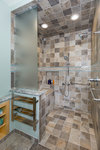


At age 69, I was a “silver sneaker” poster child – fit and healthy, living on my own, fiercely independent and proud of it. Ironically, my main fitness exercise, avid fast walking along the Twin Cities’ marvelous trails, system of lakes, and Mississippi River paths, contributed to significant wear and tear on my hips.
In 2019, after a year of pain, my Mayo Clinic orthopedic surgeon proclaimed that I needed new hips and was an ideal candidate for “bilateral hip replacement” surgery – both hips at once.
Being in great health, I assumed I’d heal like a champ and believed that coming home to my one-level condo in an elevator building would be a breeze. Ha! Preparing for my at-home rehabilitation was like facing a tsunami of details about safety and access. I was caught off guard about what I needed to successfully age in place. Things I always had taken for granted, like getting in and out of both the shower and my low-rise, Zen-inspired bed, were challenging. Before my in-patient physical therapy facility even would release me, I had to certify that I had “grab rails” installed in my shower! I had to hustle to find a reputable outfitter.
This episode was a rude awakening about the importance of considering the steps to take to successfully age in place. It’s best to plan well ahead of time.
Anyone Social Security age or older has a good chance of needing new hips, knees, or shoulders by their mid-60s. Surgeries like this are expected to become more frequent as life expectancy continues to increase. Why? Degenerative arthritis caused by wear-and-tear is one reason, coupled with multiple other realities of aging that cause decreased mobility with increased challenges of staying safe in our own homes.
STAYING IN OUR OWN HOMES IS A GOOD OPTION
According to St. Paul’s Wilder Research, Minnesota’s 65 and older adult population will more than double between 2010 and 2030 as the state’s 1.3 million baby boomers head into retirement. During the last decade, our hearty senior population was on track to increase by 41%, more than the national average.
Why? Residents here in the True North tend not to retire to other regions. Hearty and hail, greatly attached to their families, and social networks, Minnesotans stay put.
Notable in this effort to keep seniors happy and safe in their own homes is the design community, members of which often join forces with policy makers to offer ideas and services that improve and extend the lives of seniors who choose to live their lives out in their own homes.
SEEK CERTIFIED EXPERTS
Choosing a reputable remodeler is key. The National Association of Home Builders (NAHB), in collaboration with AARP and other experts, have developed the Certified Aging-in-Place Specialist (CAPS) designation, which remodelers earn through training and testing during a multicourse educational program. CAPS professionals focus on the unique needs of the older adult population, examining common barriers and the appropriate aging-in-place home modifications to solve them.
According to NAHB, a CAPS professional can:
• Recommend updates that will help a person live independently in his or her own home
• Work with an occupational therapist to develop a home modification or build plan based on the safety and functional needs of an individual or household
• Collaborate with a licensed contractor or interior designer about building and design strategies and techniques for creating attractive, barrier-free living spaces
• Provide information about building codes and standards, useful products and resources, and the costs and time required for common remodeling projects
CAPS remodelers and design-build professionals are not medical or health care professionals. Some charge hourly or flat fees to consult. It is worthwhile to note that by earning this certification they have gone the extra mile to provide critical design aspects to safely age in place.
LOCALLY-BASED CAPS CERTIFIED REMODELER
Sylvestre Remodeling & Design’s owner and chief architect, John Sylvestre, has a lifetime of experience providing ways to make home modifications that allow people to stay in the homes they love, maneuvering not only safely, but also in style. A self-confessed “baby boomer,” Sylvestre takes seriously individuals’ desires to remain in their own homes as long as possible.
His firm is CAPS certified and his portfolio abounds with stylish remodeling examples of work with typical Minneapolis housing stock. For example, the elevator they installed in a 1920s home for one client perfectly matches the door to the existing hallway doors, seamlessly integrating the design into the character of the home.
Following well-established aging-in-place guidelines, Sylvestre emphasizes basic categories for consideration:
• One-level living is a prime factor once mobility is impacted. Sylvestre explains, “We have done a number of projects that make sure there is a full bathroom on the first floor, a possible sleeping room, and a laundry.”
• Logically, the bathroom is a next critical area. It must be able to accommodate mobility aids, such as canes, walkers, or wheelchairs. Options include widening doors, replacing tubs with showers, removing curbs or step ups into showers, which also creates a more modern look, positioning shower controls in a practical location, and investing in newer wall hung toilets that have adjustable heights.
• Kitchens are another essential mobility-friendly frontier. Sylvestre suggests, “taking a look at cabinets, doorways and islands, ensuring adequate room for tasks.” Fully mobile individuals take for granted clearance space needed to open doors and drawers that would be greatly impacted when using a mobility aid like a walker or wheelchair.
Don’t get caught off guard. Spring is a good time to assess our surroundings, inside and out. Minnesota Seniors provides a free resource for seniors and their family members, with links in the Aging in Place Directory to many resources, including home remodeling companies under such categories as “Accessibility/Lifts/Elevators/Ramps” and “Home/Bath Modifications.”
Comments
No comments on this item Please log in to comment by clicking here